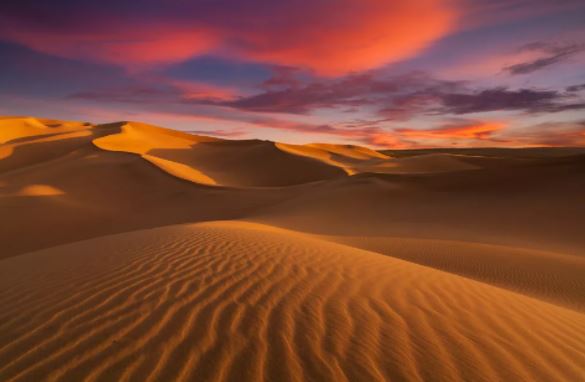Where is the Sahara desert located? Answer with a detailed explanation.
Subject
Social Science
Standard
Class 8
Views
2403
Asked By
Pari

Answer / Solution
The Sahara Desert is located in Northern Africa. It extends from the Atlantic Ocean in the west to the Red Sea in the east. It is bound by the Mediterranean Sea and the Atlas Mountains in the north and it merges into the Savanna grasslands in the south.

Answer / Solution
The Sahara desert is the world's third-largest desert in Africa. It is situated in the south of the continent of Africa, this country name is is a peninsula, with the Indian Ocean in the east and the Atlantic Ocean in the west.
- Its southernmost tip is called 'Cape of good hope'.
- This country is a high plateau, whose height has decreased from east to west.
- The eastern high is called the 'Drakensberg Mountains'. Its slope is quite sharp and the staircase in the east. It is also the origin of the river 'Wala' and 'Orange'.
The Sahara desert is a desert on the African continent. With an area of arround 9,200,000 square kilometres (3,600,000 sq mi), it is the largest hot desert in the world and the third-largest desert overall, smaller than the deserts of Antarctica and the Arctic only.
The desert comprises much of North Africa, except for the fertile area off the Mediterranean coast, the Atlas Mountains of the Maghreb and the Nile Valley in Egypt and Sudan. It extends from the Red Sea in the east and the Mediterranean Sea in the north to the Atlantic Ocean in the west, where the landscape gradually changes from desert to coastal plains. To the south, it is surrounded by the Sahel, a belt of semi-arid tropical savannas around the Niger River Valley and the Sudan region of sub-Saharan Africa. The Sahara can be divided into several regions, including Western Sahara, the Central Ahaggar Mountains, the Tibesti Mountains, the Ar Mountains, the Tenere Desert and the Libyan Desert.

Answer / Solution
The Sahara: Earth's Largest Hot Desert
The name of the desert comes from the Arabic word sahara, which means "desert".
The Sahara is the largest hot desert in the world, and the third-largest desert behind Antarctica and the Arctic, which are both cold deserts.
The Sahara is one of the harshest environments on Earth, covering 3.6 million square miles (9.4 million square kilometers), nearly a third of the African continent, about the size of the United States (including Alaska and Hawaii).
Geography
The Sahara is bordered by the Atlantic Ocean on the west, the Red Sea on the east, the Mediterranean Sea on the north, and the Sahel Savannah on the south. The enormous desert spans 11 countries: Algeria, Chad, Egypt, Libya, Mali, Mauritania, Morocco, Niger, Western Sahara, Sudan, and Tunisia.

Camels are one of the most iconic animals of the Sahara approximately 500 species of plants, 70 known mammalian species, 90 avian species, and 100 reptilian species that live in the Sahara, plus several species of spiders, scorpions, and other small arthropods, according to World Wildlife Fund.
Many reptile species also thrive in the desert environment, including several species of snakes, lizards, and even crocodiles in places where there is enough water.
Climate
The Sahara alternates from being a dry, inhospitable desert and a lush, green oasis about every 20,000 years, according to a study published in the journal Science Advances in 2019. The study's authors examined marine sediments containing dust deposits from the Sahara for the past 240,000 years. The team found that the cycle between a dry and a green Sahara corresponded to the slight changes in the tilt of Earth's axis, which also drives monsoon activity. When the Earth's axis tilted the Northern Hemisphere just a single degree closer to the sun (about 24.5 degrees instead of today's 23.5 degrees), it received more sunlight, which increased the monsoon rains and therefore, supported a lush green landscape in the Sahara.
The effect of climate change
The area of the Sahara desert has grown nearly 10 percent since 1920, according to a 2018 study published in the Journal of Climate. While all deserts, including the Sahara, increase in the area during the dry season and decrease during the wet season, human-caused climate change in conjunction with natural climate cycles, are causing the Sahara desert to grow more and shrink less. The study's authors estimated that approximately a third of the desert's expansion was due to human-made climate change.

Answer / Solution
Blanketing much of the northern third of the African Continent, or some 3.5 million square miles, the Sahara Desert, the largest desert in the world, extends eastward from the Atlantic Ocean some 3,000 miles to the Nile River and the Red Sea, and southward from the Atlas Mountains of Morocco and the Mediterranean shores more than 1,000 miles to the savannah called the Sahel. More than 16 times the size of France, the Sahara Desert blankets nearly all of Mauritania, Western Sahara, Algeria, Libya, Egypt and Niger; the southern half of Tunisia; and the northern parts of Mali, Chad and Sudan.
Top Trending Questions
- 9113 Views Thomson’s model of an atom, explain how the atom is neutral as a whole.
- 5109 Views What are the main characteristics of peer to peer systems?
- 4666 Views Draw a plot of α-particle scattering by a thin foil of gold to show the variation of the number of the scattered particles with scattering angle.
- 3706 Views Difference between Synchronous and Asynchronous Transmission
- 3482 Views Explain protocols in details.
- 3427 Views Explain advantages and disadvantages of mobile computing.
- 3319 Views Differentiate between homogeneous and heterogeneous mixtures with examples
- 3062 Views Define olfactory indicators. Name two subtances which can be used as olfactory indicator
- 3058 Views Properties of the Real Number System
- 2934 Views The first term of an AP is 5, the last term is 45 and the sum is 400. Find the number of terms and the common difference.
- 2745 Views What are canal rays? Why anode rays are called canal rays. Mention two postulates of J.J. Thomsons Model
- 2709 Views What is the difference between interactive mode and script mode in Python?
- 2699 Views Different Data Mining Tools in details
- 2611 Views Explain various Access Modifiers in Java
- 2584 Views How do you download files using ftp?
- 2579 Views What type of information is provided by MIS and DSS?
- 2521 Views What is ftp? How do you use ftp?
- 2510 Views What do you mean by data archiving?
- 2507 Views What is animation? How are animated video clips generated? Also, What are the applications of computer graphics?
- 2490 Views What Is data mining? What is the role of data archiving in data mining?
- 2486 Views Adaptability and adaption in mobile computing.
- 2483 Views What is a text-to-speech system? What are its applications?
- 2474 Views What type of creative works are given copyright? What is the period of a copyright?
- 2459 Views What is a mainframe? What are the good and bad characteristics of a mainframe?
- 2459 Views What is a recordable CDROM? How does it work?
- 2410 Views Ramkali saved Rs 5 in the first week of a year and then increased her weekly saving by Rs 1.75. If in the nth week, fher weekly savings become Rs 20.75, find n.
- 2394 Views What do you understand by aerodynamically floating head?
- 2391 Views What is speech recognition? What are its applications?
- 2314 Views What is voice mail? What are the advantages and disadvantages of voice mail?
- 2311 Views Explain the design steps of the transform mapping.
- 2311 Views Explain different types of Data Mining Techniques.
- 2304 Views What is the basic difference between transaction processing system and MIS?
- 2290 Views What is the difference between transaction processing and on-line transaction processing
- 2259 Views Write the distribution of electrons in carbon and sodium atoms
- 2244 Views Necessary conditions for autotrophic nutrition
- 2227 Views What Are the Different Types of Machine Learning?
- 2221 Views Write first four terms of the A.P. when the first term a and the common difference d are given as follows
- 2212 Views What is a DVDROM? What is its typical capacity?
- 2199 Views How do you ensure information integrity?
- 2160 Views When will you say a body is in Uniform acceleration and non-uniform acceleration?
- 2158 Views Explain Atomic number, Mass number, Isotopes and Isobars with some examples. Also give any two uses of isotopes.
- 2143 Views Write advantages and disadvantages of Hierarchical Data Model
- 2125 Views How are water and minerals transported in plants?
- 2113 Views What does an Electrical Circuit Mean, Electrical Current and its units.
- 2110 Views What is telnet? How is it used?
- 2097 Views A sum of Rs 700 is to be used to give seven cash prizes to students of a school for their overall academic performance. If each prize is Rs 20 less than its preceding prize, find the value of each of the prizes.
- 2094 Views What is SRS? Why is it important? How does one arrive at a SRS?
- 2080 Views Which term of the AP: 21, 18, 15, . . . is – 81? Also, is any term 0? Give reason for your answer.
- 2077 Views The houses of a row are numbered consecutively from 1 to 49. Show that there is a value of x such that the sum of the numbers of the houses preceding the house numbered x is equal to the sum of the numbers of the houses following it. Find this value of x. [Hint : Sx-1 = S49 – Sx ]
- 2060 Views What is feasibility analysis? How is it used?
- 2056 Views What are the factors which influence the adsorption of a gas on a solid?
- 2055 Views Naresh earns 30800 per month. He keeps 50% for household expenses. what he save per month
- 2051 Views Calculate the molecular masses of the following elements, Hydrogen, Oxygen, Chlorine, Carbon Di Oxide
- 2051 Views Write a note on civilizing mission of the colonisers and Huynh Phu So
- 2043 Views 60 percent of the students in a school are girls, If the total number of girls in the school is 690
- 2028 Views 1500 families with two children are selected randomly according to the data given. Compute the probability of a family, chosen
- 2022 Views What is rational number
- 2008 Views Define parallel connection and series connection?
- 2008 Views What is the role of desorption in the process of catalysis?
- 2005 Views What are the activities carried out during system implementation phase?
- 1998 Views Why did James Mill and Thomas Macaulay think that European education was essential in India?
- 1981 Views Explain how data mining may be used by a State Road Transport Corporation
- 1971 Views Nested Loops in C
- 1964 Views What are the different parts of a URL? Explain the purpose of each part
- 1963 Views Explain in detail about Tableau in data visualization?
- 1954 Views What rights does copyright give to the owner of the copyright?
- 1937 Views How will you find the valency of chlorine, sulphur and magnesium?
- 1922 Views What are polyatomic ions? Give examples?
- 1915 Views Describe the ideas behind the Tonkin Free School. To what extent was it a typical example of colonial ideas in Vietnam.
- 1913 Views Class 8 Quiz MCQ Basic Questions
- 1911 Views The sum of the third and the seventh terms of an AP is 6 and their product is 8. Find the sum of the first sixteen terms of the AP.
- 1894 Views A long solenoid with 15 turns per cm has a small loop of area 2 cubic cm placed inside the solenoid to its axis.
- 1886 Views What’s the difference between a generative and discriminative model?
- 1877 Views looping structure in python
- 1870 Views What is meant by Intellectual Property Rights (IPRs)?
- 1850 Views Which gas is usually liberated when an acid reacts with a metal?
- 1828 Views In a cricket match, a batsman hits a boundary 6 times out of 30 balls she plays. Find the probability that she did not hit a boundary.
- 1806 Views 2 cubes each of volume 64 cm3 are joined end to end. Find the surface area of the resulting cuboids.
- 1800 Views What is open source software? List some open source software.
- 1796 Views How is our atmosphere different from the atmospheres on Venus and Mars?
- 1772 Views Difference between Artificial intelligence and Machine learning
- 1768 Views What is system evaluation? Why is it required?
- 1768 Views Connect python to mysql database
- 1766 Views What is the syntax of Java Inheritance? Explain with example.
- 1766 Views Explain the inference rules for functional dependencies in DBMS
- 1722 Views Distinguish between speed and velocity.
- 1708 Views What is data Mining.
- 1703 Views What is Internet telephony? In what way is it different from Internet radio?
- 1697 Views If the sum of the first n terms of an AP is 4n − n2, what is the first term (that is S1)? What is the sum of first two terms?
- 1693 Views What is a Trojan? In what way is it different from a virus? How do you remove a Trojan from your PC?
- 1647 Views Explain why, when a motorcar makes a sharp turn at a high speed, we tend to get thrown to one side.
- 1644 Views What is a mobile computing?
- 1601 Views What is Internet radio? What are the advantages and disadvantages of Internet radio.
- 1599 Views Distinguish between the meaning of the terms adsorption and absorption. Give one example of each.
-
1598 Views
Check whether the following is quadratic equation:
(x + 1)2 = 2(x – 3) - 1583 Views What is Inheritance in Java? Explain.
- 1579 Views Why did a major protest erupt in 1926 in the Saigon Native Girls School in Vietnam ? Explain.
- 1576 Views How soil is formed?
- 1560 Views What is vector graphics? Where are vector graphics used?
- 1549 Views To counter the Chinese influence what steps did the French take in the sphere of education?
- 1549 Views feature of mobile computing
- 1537 Views Achievements of the Hindustan socialist Republican Association
- 1534 Views How do you know that your PC has been infected by a virus? If it is infected. how do you remove the infection?
- 1532 Views What is a computer virus? How does it infect computer systems?
- 1531 Views What is the difference between MIS and DSS?
- 1526 Views The sum of 4th and 8th terms of an A.P. is 24 and the sum of the 6th and 10th terms is 44. Find the first three terms of the A.P.
- 1519 Views What is plagiarism? Is copyright violation a criminal offence?
- 1494 Views What is a thin client? Why are thin clients preferred in certain applications?
- 1493 Views Give an example of client-server computing
- 1485 Views Types of data in mobile computing
- 1479 Views What are the three types of intellectual property? What kind of rights does IPR on computer software normally give?
- 1456 Views Shweta obtained 18 marks in a test of 25 marks. What was her percentage of marks
- 1451 Views How do you ensure security of your database?
- 1439 Views Data Mining History
- 1435 Views List some IT related products which are given patent rights and trademarks.
- 1430 Views What is mathematics
- 1421 Views What is information integrity? How is it different from data security?
- 1419 Views Two spherical bobs, one metallic and the other of glass, of the same size are allowed to fall freely from the same height above the ground
- 1400 Views What is data security? What is the difference between data privacy and security?
- 1368 Views What do you understand by image generation? What are the two types of geometrical objects which can be generated using a computer?











